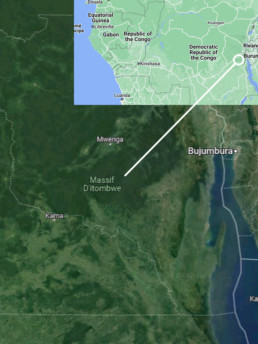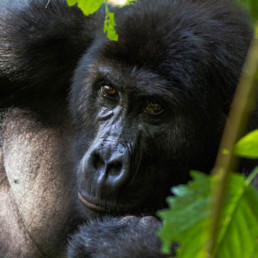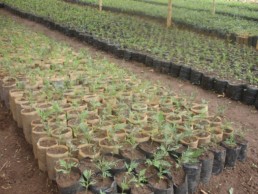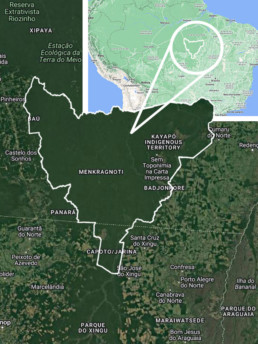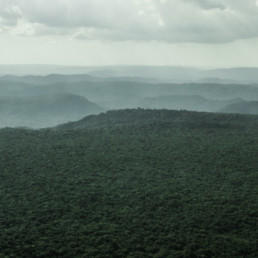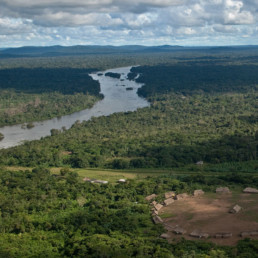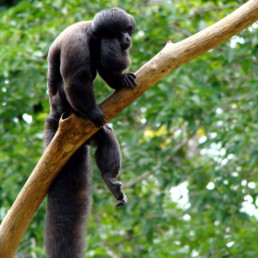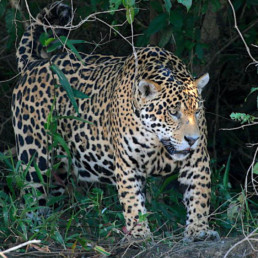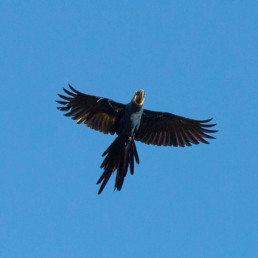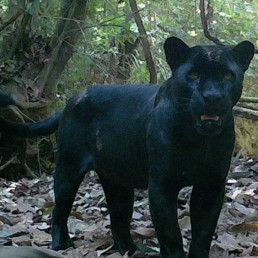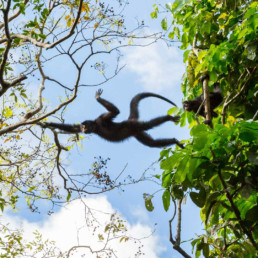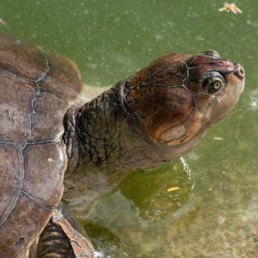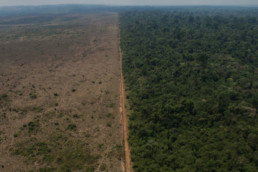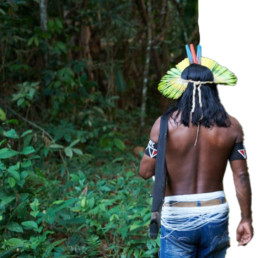DRC: Conserving community forests
Location
South-Kivu Province, eastern Democratic Republic of the Congo (DRC)
Goal
Advance the conservation of Grauer’s gorilla and other threatened species in the eastern Congo Basin.
Project Field Partner
Founded in 2009, Strong Roots is a community-based organization working at the nexus of conservation and sustainable development. They work with communities who live on the borders of Protected Areas and those living in community forests.
Size of Area Involved
6,000 km²
A wealth of life along the rift
Grauer’s Gorilla (Gorilla beringei graueri), endemic to the Albertine Rift escarpment in eastern Democratic Republic of Congo, has suffered a rapid population decline (70%) in the last 20 years. It is now listed as Critically Endangered (CR) in the IUCN Red List. The rich biodiversity of the area includes the Itombwe Massif Clawed Frog (CR), Prigogine’s Nightjar (EN), Prigogine’s Greenbul (EN), Chimpanzee (EN), Congo bay-owl (EN), Itombwe Golden Frog (EN), Yellow-crested Helmet-shrike (VU), and African Forest Elephants (CR).
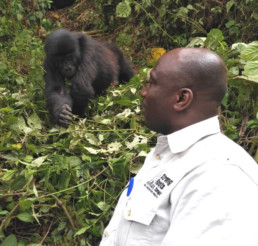
Threats:
Primates in the DRC are primarily threatened by the mining of precious minerals at artisanal and industrial scale, poaching and pollution of soil and ground water. Mining is the main driver of armed conflict in the region and stimulates human migration, wildlife trafficking, illegal logging for charcoal, colonization of forested areas, bushmeat hunting, and the construction of temporary roads in the forests. The extreme poverty in the region and the communities’ reliance on slash-and-burn agriculture are also drivers of great ape habitat degradation and fragmentation. All of this has led to a rapid population decline of Grauer’s gorilla from an estimated 16,900 individuals in the wild in the mid-1990s to fewer than 3,800 individuals today.
However, recent surveys conducted by the Wildlife Conservation Society and the Congolese Wildlife Authority show an 18% increase in Grauer’s Gorilla numbers in the high-altitude sector of Tshivanga in Kahuzi-Biega National Park resulting from conservation efforts by organizations such as field partner Strong Roots and the increased presence of the Congolese Wildlife Authority. This shows what is possible.
Constructing a biological corridor
In August 2022 years of work by Strong Roots and the communities succeeded in getting approval for thirteen officially designated Forestry Concessions for Local Communities (CFCL) covering over a quarter million hectares. This is a phenomenal achievement! Six more CFCLs await approval.
This is part of an ambitious plan to empower local communities and indigenous peoples to manage and protect their traditional lands. This forms part of a ~6,000-km² biological corridor connecting Parc National de Kahuzi-Biega to the Réserve Naturelle d’Itombwe. Crucially, the project will benefit local communities beyond simply giving them control of their forests. Strong Roots works with communities to develop sustainable livelihoods such as climate-smart agriculture and beekeeping.
Eventually community members will be included in great ape monitoring and patrolling and reforestation in the corridor area with agroforestry and native tree species. At last count, 4,212 households are direct beneficiaries of the project—people involved in carrying out its programs. These encompass 129 clans, 7 Chiefdoms, in 333 villages.
The Kayapo Project
Location
South-East Amazonia, Brazil
Goal
The Kayapo Project is an Indigenous led NGO alliance ensuring Mebêngôkre-Kayapo (Kayapo) cultural, economic, political, and territorial autonomy over more than nine million hectares of federally demarcated Indigenous lands located in the highly threatened southeastern Amazon.
Project Field Partner
ICF partners with three Kayapo NGOs: the Protected Forest Association, Kabu Institute, and Raoni Institute representing communities of the northeast, northwest and southwest sectors of Kayapo territory.
Size of Area Involved
~9 million hectares, 90,000km2. Approximately the size of South Korea, the State of Virginia, 3x the size of Belgium
Kayapo lands conserve the last remaining large, intact block of native forest in the southeastern Amazon, and maintain the connectivity of this ecoregion with the western Amazon. They confer incalculable benefits to protection of biodiversity, mitigation of climate change and preservation of the crucial role of Amazonian forests in producing rainfall over a much larger geographic scale.
Kayapo territories are large enough to protect large scale ecological processes. For example, very large areas are required to maintain tropical tree species because individuals of species are usually very sparsely distributed. Most tropical tree species depend on co-evolved animal vectors for pollination and seed dispersal across large inter-individual distances – small areas do not contain enough individuals or viable animal vector populations for regeneration over the long term. The intricate web of interdependence among Amazonian species requires large areas for these ecosystems to function and persist.
Threatened vertebrate species found in the Xingu protected areas corridor, with IUCN Red List (2016) designation.
Endangered species:
Eastern Amazonian Bearded Saki Monkey (Chiropotes satanas utahicki) Critically Endangered
White-cheeked Spider Monkey (Ateles marginatus) Endangered
Giant Otter (Pteronura brasiliensis) Endangered
Vulnerable or Near Threatened species:
Red-handed Howler Monkey (Alouatta belzebul epiphenotype discolor) Vulnerable
Lowland Tapir (Tapirus terrestris) Vulnerable
White-lipped Peccary (Tayassu pecari) Vulnerable
Giant Armadillo (Priodontes maximus) Vulnerable
Hyacinth Macaw (Anodorhynchus hyacinthinus) Vulnerable
Bare-faced Currassow (Crax fasciolata) Vulnerable
Jaguar (Panthera onca) Near Threatened
Bush Dog (Speothos venaticus) Near Threatened
Neotropical Otter (Lutra longicaudis) Near Threatened
Blue-winged Macaw (Ara maracana) Near Threatened
Chestnut-throated Spinetail (Synallaxis cherriei) Near Threatened
Territorial Surveillance
Guard posts
At the core of the Kayapo’s territorial surveillance program are the guard posts, serving as the cornerstone for the organization’s efforts to monitor and protect their extensive 2,200 km (1,375 miles) of borders, which delineate their protected forested territory from frontier society.
The guard posts play a pivotal role in signaling to external frontier societies that the Kayapo, residing in a particular area, are well-organized and committed to defending their legally recognized land rights. This proactive stance discourages potential invaders from attempting unauthorized entry. Within the guard post program, the intrinsic Kayapo determination to safeguard their territory, culture, and livelihoods merges with access to equitable income, creating a robust social deterrent against the allure and bribery attempts by goldminers, loggers, and fishermen.
The management of fifteen guard posts falls under the responsibility of three Kayapo NGOs: Associação Floresta Protegida, Instituto Kabu, and Instituto Raoni.
Expeditions
On-foot and river expeditions serve as essential complements to guard posts, contributing to the occupation and defense of border sections not yet monitored by a guard post. These expeditions also serve as crucial platforms for the transfer of traditional territorial and cultural knowledge from elders to the youth. Consequently, they offer training in both traditional and modern territorial surveillance techniques while instilling a sense of Kayapo pride.
Sustainable Income
Brazil Nut and Cumaru Harvest
The Brazil nut is a perfect blueprint for sustainable development: it can only be harvested from primary forest and generates sustainable and equitably distributed income for the communities that protect it. The defense of the forest, the well-being of the people, and the preservation of their culture are linked to a single economic activity. That’s sustainability in a nutshell!
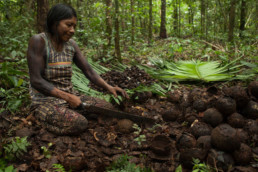
These delicious and nourishing nuts contribute to a fairly distributed annual income for Kayapo communities. Families or individuals have the option to gather and sell these nuts, aligning seamlessly with Kayapo culture and worldview as it has been a longstanding practice among them. Annually, during the fruiting season of the Brazil nut tree, which occurs from December to March in the rainy season, Kayapo families disperse throughout the forest, establishing camps near clusters of towering Brazil nut trees.
Kayapo Brazil nut and cumaru seed enterprises are examples that demonstrate sustainable income generation for forest communities is possible.
Sportfishing
Thanks to a collaboration involving Associacao Floresta Protegida, Untamed Angling, and various Kayapo communities, individuals can now explore the rainforest in a manner that honors the environment and treats the indigenous hosts fairly. The sportfishing initiative emphasizes the importance of a transparent and equitable partnership with the indigenous landowners.
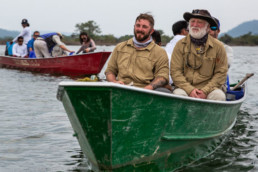
Field course
The Kayapo internship initiative provides a distinctive chance to gain knowledge and collaborate with the Kayapo People of A’Ukre, alongside their network of NGOs, universities, and government collaborators. Participants have the opportunity to visit the A’Ukre community and the Pinkaiti Ecological Research Station, gaining insights into life at the Amazonian frontier. The funds generated through the program are directed towards investments in the A’Ukre community.
Against all odds
The Kayapo have successfully defended their land from the relentless attacks of frontier society. The resilience of the Kayapo-NGO alliance can be observed from space, as satellite images reveal virtually no deforestation amidst a sea of agricultural expansion and gold mining.
The map below reveals the state of the 10.6 million hectare block of ratified Kayapo Indigenous territory in January 2022. Kayapo indigenous territories are outlined in yellow (NGO Kayapo project territory) with an eastern band of ~ 1.2 million hectares outlined in purple (does not form part of this project) that receives no conservation NGO investment and has been lost to the frontier of illegal activity (logging and mining). Kayapo Guard Posts are marked in purple.
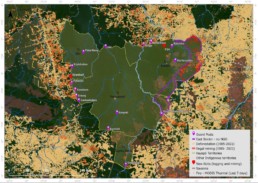
Saving the Horned Curassow: Conservation in Bolivia
An ambitious goal: Saving Bolivia’s Most Endangered Bird
The Critically Endangered and endemic Horned Curassow (Pauxi unicornis) is losing its habitat at an alarming rate, and without direct conservation actions could be the first bird to go extinct in Bolivia.
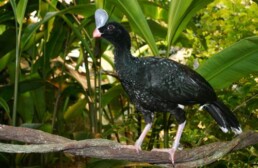
A powerful partnership: Armonía’s Work with Yuracaré People
In 2021, our field partner Armonía identified two critical habitats for the Horned Curassow within the TIPNIS, a vast protected area in Bolivia. Using camera traps, they documented 17 individuals across 10 locations — proof that a viable population still survives deep within Yuracaré Indigenous territory. To build a foundation for long-term protection, Armonía engaged directly with the Yuracaré people, conducting in-depth socio-economic research to understand their development needs and how conservation can align with their vision for the future. This is the only region in Bolivia where Indigenous communities have both legal and territorial authority within a national park — making their leadership essential to saving this species from extinction.
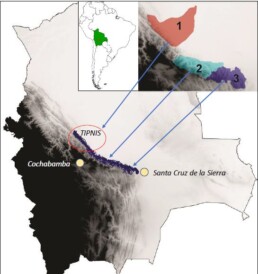
Map: The blue area indicates the known Horned Curassow distribution in Bolivia. Light gray indicates lowlands and black the highlands. Red circle indicates the TIPNIS and project focus area. The Critically Endangered and Bolivian endemic Horned Curassow (Pauxi unicornis) occurs in undisturbed foothill forest between 400 to 1,400 m.a.s.l. This species is found within the TIPNIS (1), Carrasco (2) and Amboró (3) National Park though its habitat is heavily affected by illegal coca agriculture and human invasion. Only the TIPNIS National Park has Yurucaré indigenous territories.
Foothill forest habitat at Isiboro Sécure Indigenous Territory and National Park. Ruth Marquez
🌿 Horned Curassow Conservation Through Birdwatching Tourism
That’s why our partners are working hand-in-hand with Yuracaré communities to build a sustainable birdwatching tourism model that benefits both people and wildlife. At the heart of this effort is a newly developed observation trail in Secejsamma, where confirmed sightings have proven the species still survives. Guided tours, planned for launch in 2025, are designed to empower the community economically while maintaining low-impact, conservation-friendly standards.
More than protection — an opportunity
To bring this vision to life, the project is training Yuracaré guides in advanced birdwatching techniques, strengthening a community tourism committee, and improving infrastructure with a functional basecamp for overnight visitors. A pilot birding trip will help fine-tune the experience and prepare the trail for promotion to national and international birdwatchers. By turning the Horned Curassow into a flagship species for ecotourism, we aim to create a model where conservation and local livelihoods thrive together.
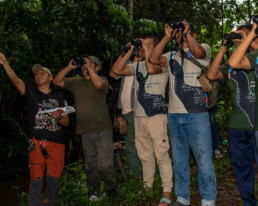

Our outstanding field partners - Asociación Armonia
Asociación Armonía is a Bolivian accredited non-profit conservation organization created in 1993. It is supported by the regional governments of Beni and Santa Cruz and the Bolivian national park administration (SERNAP). In 2009, Armonía received a certificate of commendation from the Bolivian government for its efforts to protect Bolivia’s birds and their habitats. Armonía manages twenty conservation programs, including twelve programs with threatened species.
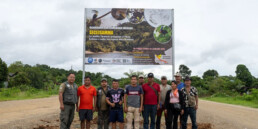
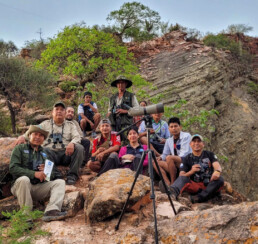

Join hands with our project field partner Asociación Armonía in protecting the Horned Curassow and all the other species thriving under the stewardship of the Yuracaré people

